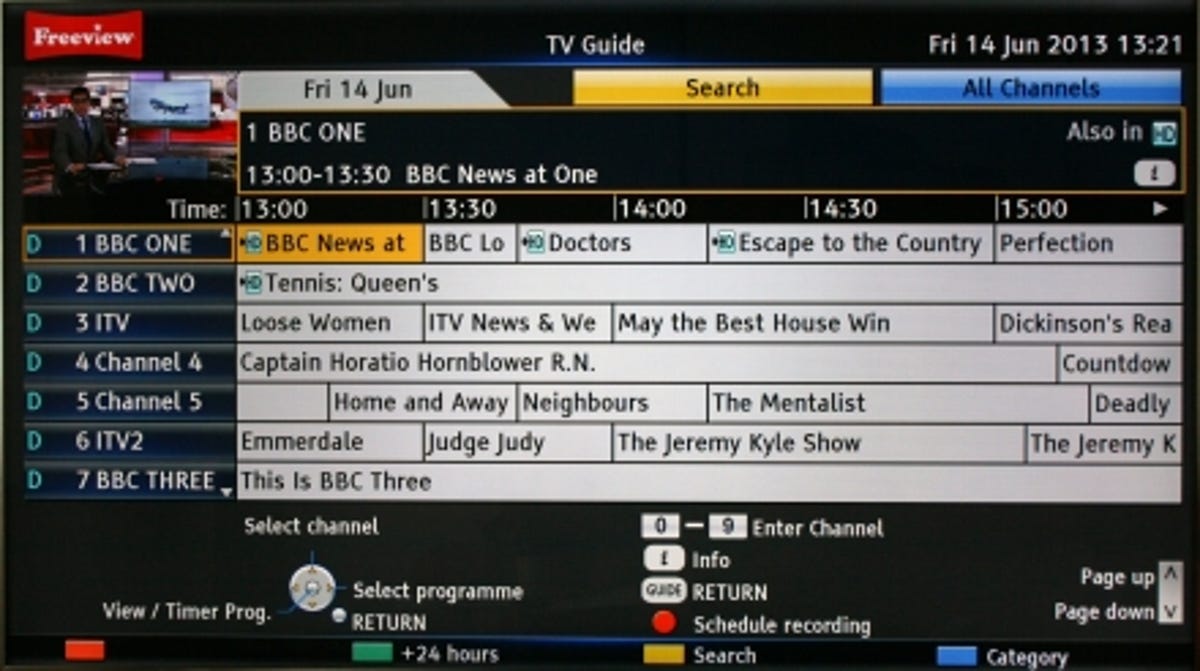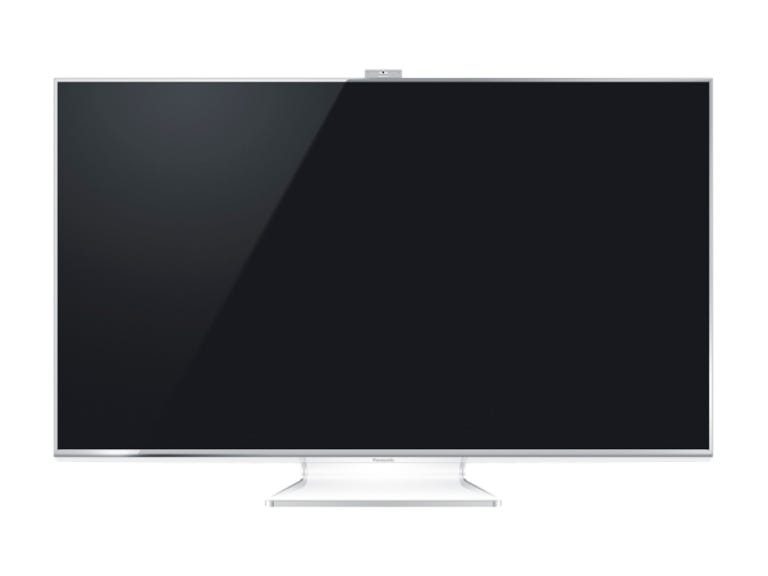 Why You Can Trust CNET
Why You Can Trust CNET Panasonic TX-L55WT65 review: Panasonic TX-L55WT65
Panasonic's top of the range LED TV looks classy, is easy to use and has sharp pictures. But it's very expensive, and rivals offer more.
The TX-L55WT65 is the crowning glory of Panasonic's current range of slim-line LED TVs, with more bells and whistles than a Brazilian carnival. You'll find not just dual Freeview and Freesat HD tuners, but also a camera, a clever new smart TV system and local dimming support.
The Good
The Bad
The Bottom Line
This TV is far from cheap though, with the 55-inch version I tested costing around £2,350 (it's also available in 42-, 47-, 50- and 60-inch models). So is it worth the premium over more affordable models in Panasonic's range, such as the DT65 and FT60?
User interface and EPG
Panasonic has created a whole new user interface for this year's TVs. It's essentially a homescreen that gathers stuff like the Smart TV apps, widgets and other goodies together in one place. Unlike other systems, Panasonic's allows you to create customised versions of the homescreen by adapting four of the provided templates. It's a clever idea that really works well from a user perspective as it saves you having to jump between different screens to access the apps you most commonly use.
The settings menus are still separate from this new system and don't look quite as classy, but they're speedy to use when you're jumping between the various picture and audio options. They give you plenty of control over the set's pictures too, as there's a full colour management system onboard. You now also get independent controls for contrast and backlight level, which wasn't supported on last year's WT50.

Another plus is the updated programming guide. It now has a video window to the top left-hand corner so you can check what's coming up later on in the day or evening without losing all audio and video from the show you're watching. The guide still looks rather dull and basic next to those on Sony and Samsung's sets, but it's very legible from a distance and makes it quick to jump between different programs on the timeline.
Design and connections
Last year's WT50 model was a handsome devil, and those genes have definitely been passed down to the WT65. It has a very different stand to the other TVs in Panasonic's 2013 lineup. The one used here is like a curved Perspex wedge with metal edging -- and looks better than that makes it sound. It helps to give the TV a light, floating-on-air look that's very appealing.
Reinforcing this airy feel is the fact the bezel around the screen is extremely narrow. Panasonic has also added a Perspex edge that drops down from the bottom of the screen. This is lit by an LED that makes the light runs across the bottom to create a cool sci-fi effect. The only downside is that the stand does tend to show up dust, so it might not be the best option if cleaning is, you know, not really your thing.
Like most high-end TVs these days the WT65 comes with two remotes: a standard zapper and a touchpad controller. The standard zapper is ace. It's chunky, without being uncomfortable to hold, and has a backlight so you can light up the buttons when you're watching a movie with the lights dimmed. The secondary remote has a circular touchpad and a trigger button on the bottom. It's a slight improvement on last year's similar touchpad controller, but still not as easy to use as Samsung's touchpad remote or LG motion controller.
Sadly Panasonic has cut the number of HDMI ports to three on this model, when most 55-inch TVs now come with four. It does have three USB ports though, and there are dual tuners for both Freeview HD and Freesat HD. If you plug a hard drive into one of these USB ports you can use the set as a full-blown PVR because the dual tuners allow you to watch one channel while recording another.
There's also a mini jack input that lets you to connect Scart devices up to the TV via a small breakout cable, and naturally there's a set of component inputs too. There's an Ethernet connector on the rear for piping in the Internets and Wi-Fi built-in too.
Smart TV system
This year Panasonic has introduced an all-new Smart TV system which is head and shoulder above what was available on the company's older models. It uses a new homescreen that pops up when you start the TV or press the Home button on the remote. There are four different prebuilt homescreens you can choose from, but the clever bit is that you can also create your own using the templates provided. This is very quick and easy to do too.
It's a great idea and works extremely well in practice. The only problem, though, is that the range of apps available on the platform isn't as good as some rivals, particularly Samsung. Whereas Samsung has apps for iPlayer, ITV Player, 4oD, Demand 5, Netflix and Lovefilm, Panasonic only offers iPlayer and Netflix from that line-up.
There are plenty of other apps, of course, including Blinkbox, BBC Sport, Facebook, Twitter and Picassa, but people want mostly video-based apps on their TV, so Panasonic really needs to put more effort in on this front.
This TV also lets you set up different homescreens for different family members and have the TV flick between them automatically via face recognition using the onboard camera. This sounds great, but unfortunately this feature isn't very reliable and pretty much doesn't work at all if your room is dimly lit.
I do like Panasonic's apps for iOS and Android devices, which you can download for free -- they let you 'throw' pictures, videos and websites to the TV by selecting them within the app and dragging them towards a TV icon at the top of the screen. What's more, the app now supports second-screen viewing. As the set has dual tuners onboard you can stream one channel to your iPad, for example, while someone watches another channel on the TV screen.
The presence of dual tuners also means that if you plug a hard drive into one of the TV's USB ports you can now use it as a full PVR because it allows you to record one channel while watching anther.
Naturally, this model also supports digital media playback. Format support is, on the whole, quite strong as it'll happily stream HD MKV files as well as Xvid and DivX formats across a network or play them back from SD cards or USB drives.
Audio quality
When it comes to audio quality, the WT65 is pretty middling. Panasonic has added a mini woofer to the rear of the TV, but it doesn't help hugely when it comes to this set's bass. Soundtracks in movies still lack low-end punch.
You can crank up the bass a little using the EQ found in the audio menu, but the results aren't exactly amazing -- it still tends to sound quite wooden. On the plus side, it does create a convincingly wide stereo soundstage and its strong mid-range performance means dialogue generally sounds quite crisp and clean.
2D picture quality
The WT65 is certainly a looker in terms of design, but the question is does it deliver in terms of picture quality? The answer is not clear cut, I'm afraid, as in a bright room the WT65 looks very engaging, but in a darker environment its flaws become more obvious.
Let's start with the positives. The screen really does deliver bags of sharpness. HD feeds practically bristle with crisp detail, with every blade of grass or skin follicle reproduced with impressive precision. The upscaler works wonders on standard-definition sources too, managing to adding in just the right amount of sharpness to stop them from looking blurry, but without highlighting noise and other nasty artefacts in the signal.
The TV's viewing angles are impressively wide, so you don't see lots of shifts in contrast if you're viewing it from a more side-on angle. Colours also look very warm and are particular sympathetic to movies from Blu-ray.
The TV's negative issues revolve around its black-level performance. With the backlight dimming turned off, black levels aren't particularly deep, which isn't surprising, as this is the case with most LED sets that support local dimming. The problem, however, is that when you turn it on you'll find hat its diming system just doesn't seem to be as sophisticated or as transparent as the systems used on Sony's W905A or Samsung's F8000 TVs -- its two main competitors.
The dimming zones are rather too obvious when you're watching scenes with combinations of lots of dark and bright areas in the same image, and its backlighting just isn't as uniform and even across the display as I would have liked.
3D picture quality
Like all of Panasonic's LED screens this year, the WT65 is built around an LG panel and as a result relies on passive rather than active 3D technology. This means that it uses the cheaper polarised 3D specs, very similar to those you find in cinemas.
There are four pairs of specs provided with the TV, but extra pars can be bought for a couple of quid each, so a passive 3D set like this one is the best option if you want to watch movies or sports in 3D together with lots of people. The glasses are very comfortable to wear, as they're light and don't flicker like most active 3D glasses.
A passive screen like this halves the horizontal resolution for 3D viewing. On smaller screens you can't really tell the difference from a normal viewing distance. At this larger 55-inch screen size you do notice the drop in resolution, however, as jaggies on diagonal edges or curves in the image are slightly more apparent than they are on smaller screens.
Nevertheless, the set still produces very bright 3D pictures with a strong and convincing sense of depth. There's almost no crosstalk either, as long as you don't have the set placed too low down or too high up. This is because at about 15 degrees above or below a normal viewing angle the 3D effect breaks up, as it does on all passive displays. This would only really be an issue if you mounted the screen very high up on a wall though.
Conclusion
The Panasonic TX-L55WT65 is far from a bad LED TV. In fact it's got plenty going for it, thanks to its sophisticated design, sharp and bright HD pictures and easy to use smart TV system.
But at nearly £2,500 it just seems overpriced to me, especially as it doesn't offer a big hike in performance over the company's cheaper DT65 LED screen.
If you're willing to put up with a thicker chassis, then ultimately Panasonic's excellent VT65 or Samsung's F8500 plasmas are better options, as they both have similar headline features while boasting far superior picture quality than you'll get from any LED screen on the market today.


